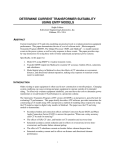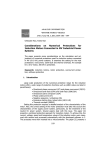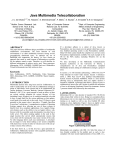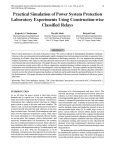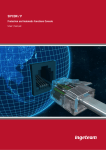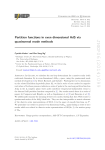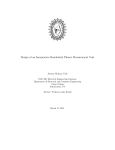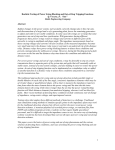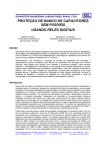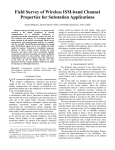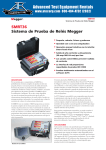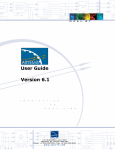Download Development of a Digital Motor Universal Management Relay
Transcript
Development of a Digital Motor Universal Management Relay Simulator Mojtaba Khederzadeh, and Hossein Ansari-Sharezai Abstract—In this paper a new interactive simulation environment is proposed for protective relay design and evaluation as well as for protective relay testing. The salient features of a motor universal management relay such as different protective devices as well as control, monitoring, communication could be designed and evaluated in this software environment. It could serve as a standalone tool to relay designers both from hardware and software points of view. It is developed by MATLAB/Simulink Ver. 6.5, Release 13. In this version, the Power System Blockset is replaced by SimPowerSystems, enabling to simulate almost any circuit with the phasor simulation feature. The simulation time is reduced dramatically with this method; hence, the efficiency of the relay simulation has been increased considerably. Index Terms—Protective Relaying, Motor Protection, Thermal Modeling, Relay Simulation, Interactive Simulation Environment, MATLAB, SimPowerSystems. P I. INTRODUCTION ROTECTIVE relay design and implementation is a sophisticated task that requires both hardware and software considerations. The algorithms should be developed based on the hardware capabilities. If the computation requirements are not fulfilled by the selected processor(s), the hardware design needs to be reevaluated. The common practice is the design and implementation of a prototype based on the preliminary evaluation of the computational requirements of the protection, control, monitoring, oscillography and communication tasks. Hence, there is a need for a simulation tool, which could simulate the relay both from hardware and software point of view. M. Khederzadeh is with the Department of Electrical Engineering, Power & Water Institute of Technology, P. O. Box: 16765-1719, Tehran, IRAN(phone: +98-21-7312783; fax: +98-21-7310425; e-mail: kheder@ pwit.ac.ir). H. Ansari-Sharezai is with the Iran Power Development Center (IPDC). Different approaches to modeling protective relays and related power system events have been discussed in [1]. Wellknown software packages can be used to simulate power system faults in both the time-domain (electromagnetic transients) [2, 3, 4] and phasor (unbalanced steady state) [5, 6, 7] modes. Some of the packages have the provision for incorporating protective relay models developed by the user [2, 3] while the others have the generic relays models already included [4, 5, 6, 7]. In all the mentioned cases it is difficult to add the modeling and simulation features to specific protective relaying concepts that go beyond the level of detail originally provided by the software. Additions of new relay models and implementations of specific fault scenarios as well as the flexibility of changing the way the models of relays and power system interact is constrained by the specific user and programming interface rules embedded in the existing software. The relays can be more accurately and more efficiently modeled by using either C language or a commercial software package with pre-defined libraries such as MATLAB's SIMULINK [8]. An embedded system in a digital relay usually consists of one host processor and one or multiple DSPs. In general, there is a finite amount of processing resource available in any given microprocessor design. This is a function of the speed and architecture of the processor (or processors) and the speed of peripheral items such as, memory, data bus, etc. For a given hardware platform, the relay designer must decide on the best compromise in allocating this finite processing resource to create a multifunction relay. Several of the most important factors that the relay designer balances in the design of a relay are: number of functions included, how often each function is processed and efficiency of the code. The salient feature of the proposed software is an enhanced environment for the evaluation of the burden of the processing resources and the efficiency of the protective devices algorithms. In the proposed software environment, the relay designer has the freedom to select more processors or optimize the code based on the real needs of updating the operating quantities. The efficiency of the algorithms could be judged easily by simulating the conditions for the operation of the desired protective device. This important feature is based on the capability of modeling of the power network and protective relays, and their interactive simulation for a variety of the events in power system. These events encompass many scenarios, including various faults and normal operating states, and correspond to specific time scales. In this paper, MATLAB Version 6.5 (R13) with the enhanced Simulink/SimPowerSystems Version 2.3 [9] is selected as the main engineering tool for performing modeling and simulation of power systems and relays as well as for interfacing the user and simulation programs. As a part of the Physical Modeling family of products, SimPowerSystems work together with Simulink to model electrical, mechanical, and control systems. Through one interface the operator is able to select and set models of the appropriate power systems and relays, to interface the relay models to the models of the power system, to define power system disturbance scenarios and to initiate various simulations corresponding to specific time intervals of the disturbance. The proposed environment simulates a microprocessorbased relay designed for the protection and management of medium and large sized motors. Overvoltage and undervoltage protection, thermal overload, fault diagnostics are provided. It provides phase, neutral, ground and negative sequence, instantaneous and time overcurrent protection. The time overcurrent function provides multiple curve shapes for optimum co-ordination. The relay also features an enhanced Thermal Model with custom curves, current unbalance biasing, and running and stopped exponential cooling curves. An optional RTD module allows for the Thermal Model RTD Bias function. Motor start and supervision functions include Starts Per Hour, Time Between Starts, Restart Time, Acceleration Time, Emergency Restart, and Start Inhibit. Sensitive Directional Power, Mechanical Jam, and Current Unbalance elements are also included as standard functions. Voltage, current, and power metering is considered. Current parameters are available as total waveform RMS magnitude, or as fundamental frequency only RMS magnitude and angle (phasor). It is worth saying that the main objective in the design of this work is the simulation of an actual relay for design and implementation purposes. Teaching the fundamentals of protective relaying was not the major goal. This issue has been done in other papers [10]. The paper is organized as follows. Section II gives a short description of a motor management relay with its new features owed to the digital technology, like thermal overload protection. An overview of motor fault events and normal operating states, as well as the selected model of an actual power network are given in section III. Section IV provides insight into the motor management relay modeling and simulation tools. Section V defines the new simulation environment for a motor universal management relay design and evaluation. The conclusions are given at the end. II. MOTOR MANAGEMENT RELAY SPECIFICATION Protection, monitoring and metering shall be supplied in one integrated digital relay package for application to medium and large horsepower motors suitable for incorporation into an integrated station control system. A. Protection Functions: 1) Thermal Overload Protection The Thermal Overload element must provide dynamic rotor protection both during acceleration and stall conditions. The algorithm shall include these key elements: • Overload protection using Standard and userprogrammable overload curves • Negative sequence current biasing using the negative to positive sequence ratio scaling to include system unbalance heating effects. • Stator RTD biasing (hot/cold compensation) with type selection. • Independent motor cooling time constants for both running and stopped conditions • Restart inhibition to prevent thermal damage during successive starting. • Inhibit override to allow an Emergency restart. 2) Restrained Stator Differential element • The differential element shall have a dual slope characteristic. • A directional check and saturation detection algorithm shall be included for enhanced performance during CT saturation. 3) Current Unbalance protection • This element shall use the negative to positive current component ratio method. • The element shall adapt to overload conditions. • The element shall detect “single-phasing” 4) Overcurrent Protection • Phase, Neutral, and Ground Instantaneous Overcurrent (IOC) protection shall be provided with a settable time delay • Ground Time Overcurrent (TOC) protection, with: IEEE, IEC, IAC, I2t, definite time curves 5) Voltage Protection • Phase, Neutral, Auxiliary and Negative Sequence overvoltage protection • Phase and Auxiliary undervoltage protection, both with definite and inverse time characteristics • The voltage element operating times shall be user adjustable. 6) Sensitive Directional Power element • Two elements shall be included each consisting of two stages. • The element characteristic angle shall be adjustable. 7) RTD monitoring B. 1) 2) • Control Functions: Programmable logic including non-volatile latches Sixteen curves for user-definable protection functions Flexible control of all input and output contacts shall be provided. • All elements shall have a blocking input that allows supervision of the element from other elements, contact inputs, etc. • The relay shall allow for peer-to-peer communications direct fiber or G.703 or RS422 interfaces. 3) Switchable Setting Groups • The relay shall have switchable setting groups for dynamic reconfiguration of the protection elements due to changed conditions such as system configuration changes, or seasonal requirements. C. Metering Functions: 1) Voltage, Current, Power, Energy • Voltage (phasors, true RMS values, symmetrical components), current (phasors, symmetrical components, true RMS values), real, reactive and apparent power, power factor, energy and frequency. 2) User-programmable oscillography 3) Trip circuit monitoring Normally, a motor management relay includes the following protection devices [12]: Fig.1 Single Line of a Motor Management Relay The device numbers and functions are according to Table 1. This is a typical motor universal management relay that can be found commercially [12]. Usually, the time overcurrent devices have IEEE Moderately, Very, Extremely Inverse curves; IEC (and BS) A/B/C and Short Inverse curves; definite time curves and a few user-programmable ones. TABLE 1 DEVICE NUMBERS AND FUNCTIONS D. Hardware The structure of a microprocessor-based relay is shown in Fig. 2. The parameters of each module should be carefully selected in order to have an optimized design. dramatically reducing the computation time. It provides computations similar to EMTP/ATP permitting modeling of both the power system and its controls in the same environment, and thus, facilitating closed-loop simulation. In order to closely emulate the actual relay, a user-friendly model with different capabilities has been designed. Fig. 3 shows the relay in the Simulink modeling page. The status indicates normal operation or tripped condition. Trip type indicates the protective device function and number (for example: Excessive starting time, locked rotor 48/51LR). Trip date and time is for data logging and indicates the date and time of the event. The last line is for the simulation time starting from the beginning up to the relay trip. Since the user determines the instant of fault, this value shows the relay trip time from the inception of fault to the issue of the trip command. Fig. 2 Block diagram of a microprocessor-based relay The important points in this part are: transducers (voltage and current transformers), isolation transformers, anti-aliasing filters, A/D convertors, digital inputs and outputs. The sampling rate is a key factor. Usually, it is between 16 to 64 samples per cycle. Sometimes a block is necessary to change the gain of the input signals in different states. These parameters that explicitly relates to hardware can greatly affect the software, like the required degree of digital filtering. III. RELAY SIMULATION SOFTWARE STRUCTURE In this work MATLAB Version 6.5 (R13) with the enhanced Simulink/SimPowerSystems Version 2.3 [9] is selected for simulation of the power system and the universal motor management relay. MATLAB is selected for its popularity in the university environment and increasing recognition in power engineering industry; its flexible software structure comprising libraries, models and programs in order to integrate different model components in one package conveniently; its time domain solver, SIMULINK, to create a friendly and open system to add new models and libraries; its quick and efficient expansion due to the powerful calculation and visualization means without the necessity to develop any extra programming tools; its rich and powerful TOOLBOXes; and its newly developed SimPowerSystems, previously called Power System Blockset [11] enabling modeling the basic components of power systems, while Fig. 3 Motor Universal Management Relay in Simulink The basic blocks (protective devices) have been developed as masked subsystems with s-functions performing the required operations. The icon of the motor universal management relay has been used in a dynamic way. It reflects the changes during the execution of the program, not as entry to the program. For example, when the undervoltage device (27) operates, the relay icon shows the trip type dynamically. It uses the GUI programming for data input and output. The data entry mechanism of the mask has been extensively used to input the block parameters. Consequently, the locked library contains both the blocks' structures and pre-defined default data. The help link of the mask has been used to provide on-line help in the form of meta-text documents (html or rich text format). Some blocks (file converters, for example) have been developed as MATLAB programs (mfiles). The inputs to this relay are: 3 phase currents from the motor terminals, 3 phase voltages, 1 input from Core Balance CT (if available) and 3 phase currents of the neutral side of the motor windings for differential protection. By clicking on the relay, the setting menu appears (Fig. 4). This figure shows different protective device functions for motor. The user can enable or disable any device and perform the settings by clicking on the desired icon. Since the other power system equipments such as generator, transmission line and transformer have common protective devices; this software environment could be extended to cover these equipments. Fig. 4 also shows the setting menu for thermal overload as an example. The user observes this menu by clicking on the associated icon. The relay also delivers the captured data and events in IEEE Comtrade format [13]. A. Hardware Modeling Fig. 5 shows the masked subsystem of the relay. This block shows analog multiplexer, anti-aliasing filter, A/D convertor, DC offset removing block and processor. Fig. 4 Setting Menu for different protective devices B. Protective Device Algorithms These algorithms are developed for optimized operation of the relay. One of the important ones is thermal modeling. This protective device is developed and progressed by the aid the digital technology, enables one to solve differential equations Fig. 5 Relay hardware block diagram Although the general blocks like analog filter and A/D can be built by different methods, but the important point is the sampling rate. In this regard fixed interval processing loops can be designed and evaluated. For example, the algorithms may be structured such that there is the A/D interrupt running at the A/D sample rate. The processing of the sample data into operating quantities (phasor estimation for example) may not be done every time new sample data is acquired. This high processor burden task would only be done as often as the highest priority tasks are called. The high priority instantaneous trip functions and output logic functions may be in 1/8 or ¼ cycle loop. Another grouping of lower priority functions may be processed only every cycle or every other cycle. In this simulation the following approaches have been used: • The sampling rate depends on the system frequency, which, changes with time. In this simulation, the system frequency is measured per arrival of (one or multiple) of new samples. Based on the measured frequency, the sampling interval is determined. • The simulation benefits from the sliding window approach for updating the phasor measurements. The user can select the updating period by clicking on the “SAMPLING” icon in setting menu (Fig. 4). For 16 samples per cycle, the user can select 0 (means updating every cycle) to 15 (means updating every sample). in real-time. 1) Thermal Overload Fig. 6 shows the thermal model used in motor start-up. Fig. 7 indicates the thermal model in running state [14]. The digital equivalent of these models are solved in the software environment, based on the motor nominal data. As can be seen from Figure 4, the setting menu for thermal overload receives the Service Factor (SF), Locked Rotor Current (IL), Locked Rotor Time From Operating Temperature (To), Locked Rotor Time From Ambient Temperature (Ta) and initial condition temperature rise as input data. 2) Excessive Stating Time/Locked Rotor Fig. 8 shows the block diagram of the device function 48/51LR. This function is three-phase. It comprises three parts: • Excessive starting time: during starting, the protection picks up when one of the 3 phase currents is greater than the set point Is for a longer period of time than the ST time delay (normal starting time), • Locked rotor: at the normal operating rate (after starting), the protection picks up when one of the 3 phase currents is greater than the set point Is for a longer period of time than the LT time delay of the definite time type. Starting is detected when the current consumed is 10% greater than the Ibase current, or I23 input is activated by a contact from motor shaft rotation detector. The ST time delay, which corresponds to the normal starting time, may be reinitialized by a logic data input for particular uses (input I22). • Locked rotor at starting stage: large motors may have very long starting time, due to their inertia or the reduce voltage supply. This starting time is longer than the permissive rotor blocking time. To protect such a motor LTS timer initiate a trip if a start has been detected (I>Is) or if the motor speed is zero. For a normal start, the input I23 (zero-speed-switch) disables this protection. When the motor re-accelerates, it consumes a current in the vicinity of the starting current (>Is) without the current first passing through a value less than 10% of Ibase. This information may be used to: • Reinitialize the excessive starting time protection, • Set the locked rotor protection LT delay to a low value. 3) Phase Overcurrent Phase overcurrent protection is three-pole. It picks up when one, two or three of the phase currents reaches the operation set point. It is time-delayed. The time delay may be definite (DT) or IDMT (standard inverse SIT, very inverse VIT or LTI, extremely inverse EIT, ultra inverse UIT, RI). The function includes an adjustable reset time T1 (DT characteristics) (timer hold). Fig. 6 Motor starting thermal element Fig. 8 Block diagram of device function 48/51LR IV. INTERACTIVE POWER SYSTEM AND RELAY SIMULATION In the simulation environment, different faults can be simulated and the behavior of the relay could be checked. Here, only two cases are introduced. Fig. 7 Motor running thermal element A. Thermal Overload Simulation In Fig. 9, conventional overload (overcurrent relay used for overload) and thermal overload models are subjected to a cyclic overload with the motor initially at 0.846 per unit of thermal capacity. The cyclic current in Figure 11 alternates between 1.4- and 0.4-per-unit current every 10 minutes. Note that the average of the currents squared and the rms current is 1.03 p.u. The cyclic current is not an overload that raises the temperature to the trip value. Figure 9 shows the cyclic temperature response of the thermal model reaches a 1.06 average, or 80 percent of the trip value. The overcurrent relay model does not measure temperature and trips because it cannot account for thermal history. V. CONCLUSION In this paper, a novel modeling and simulation environment is developed that could serve as an aid to relay designers and manufacturers to evaluate their protective algorithms and hardware structures. Different motor protective devices can be enable/disabled by the user. All the protective devices are collected and optimized in one unique s-function that emulates the actual relay. The relay operates in a dynamic manner and its status is visible on the screen. Advanced protective algorithms like thermal overload could be best tested and debugged by the developed environment. It allows evaluation of both individual relays as well as the interactions among relays incorporated into a protective relaying system under a variety of power system operating conditions. The sampling interval is adaptively adjusted by the system frequency. The enhanced environment allows for the evaluation of the burden of the processing resources. In this regard fixed interval processing loops can be designed and evaluated. The processing of the sample data into operating quantities may not be done every time a new sample data is acquired; it could be selected by the user. This high processor burden task would only be done as often as the highest priority tasks are called. REFERENCES Fig.9 Response of the Models to a Cyclic Overload Current B. Differential Relay Operation Fig. 10 shows the simulation of differential relay operation. The power system consists of a 3-phase source, cable, instrument transformers, breakers, and related measuring devices. The relay trips after 20 msec. [1] [2] [3] [4] [5] [6] [7] [8] [9] [10] P.G. McLaren, C. Henville, V. Skendzic, A. Girgis, M. Sachdev, G. Benmouyal, K. Mustaphi, M. Kezunović, Lj. Kojovic, M. Meisinger, C. Simon, T. Sidhu, R. Marttila, D. Tziouvaras, “Software Models for Relays,” IEEE Transactions on Power Delivery, Vol. 16, No.2, pp. 238246, April 2001. CanAm EMTP User Group, Alternative Transient Program (ATP) Rule Book, Portland, 1992. EMTP Reference Manual, BPA, August 1986. EMTDC User’s Manual, Manitoba HVDC Resource Center, 1996. CAPE User’s Manual, Electrocon International, 1997. Tractabel-EDF, “EUROSTAG Software,” Release Notes, ver. 4.1, December 2000. ASPEN User’s Manual, ASPEN Inc., 1995. The MathWorks, Inc., Using Simulink, Version 3, 1990. The MathWorks, Inc., SimPowerSystems version 2.0 User’s Guide, 2002. M. Kezunovic, S. Vasilic, "Advanced Software Environment for Evaluating the Protection Performance Using Modeling and Simulation," CIGRE SC 34 Colloquium, Sibiu, Romania, September 2001. [11] The MathWorks, Inc., Power System Blockset User’s Guide, Version 1, 1999. [12] GE Universal Motor Management Relay, User Manual (M60). [13] IEEE Standard C 37.111-1991: “Common Format for Transient Data Exchange (COMTRADE) for Power Systems,” Guides and Standards for Protective Relaying Systems, IEEE 1995. Fig. 10 Differential relay operation [14] Stanley E. Zocholl, Armando Guzmán, “Thermal Models in Power System Protection”, WPRC’99. M. Khederzadeh received the B.Sc., in Electrical Engineering from Sharif University of Technology in 1980, M.Sc. from Tehran University in 1990 and Ph.D. in electrical engineering from Sharif University of Technology in 1996. His employment experience included the TAVANIR Company. His special fields of interest included power system control and protection. He is currently working as an Assistant Professor in Electrical Engineering Department, Power & Water Institute of Technology, Tehran, IRAN. His research interests include: power system transients, protection, stability and dynamics and application of AI in power systems.









